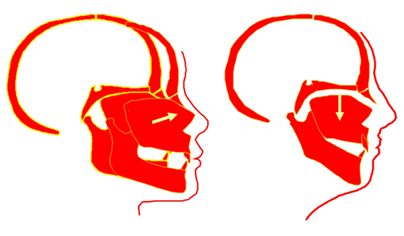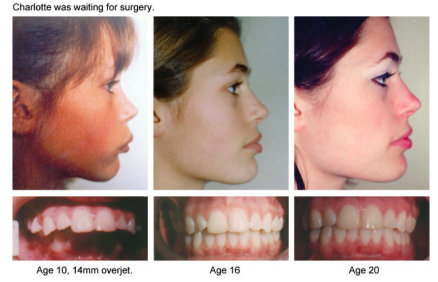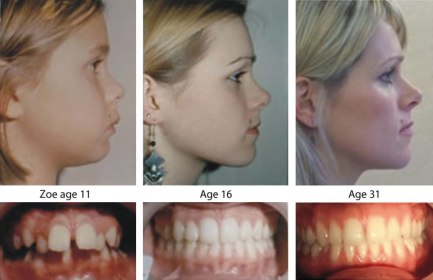Professor John Mew, born in 1928, is a dentist, researcher, orthodontist as well as an anthropologist. His father was a dentist from whom he developed his interest in dentistry. His lateral-thinking mind allowed him to question whether the causes of malocclusion were genetic or influenced by environmental factors and he actually provided answers.

In 1965, he became an orthodontist after being qualified as Maxillofacial surgeon in 1953. He found quite perplexing how the aim of corrective jaw surgery was (and still is) to bring the maxilla and mandible forward (as can be seen in the example of Figure 2), while orthodontics was actually further receding the maxilla by extracting teeth (usually the upper premolars, as in the case of Figure 3).


- Either the palate was relapsing, narrowing again.
- Or the expansion had a stable results.
- Or, most surprisingly, some palates were continuing to expand even after appliances were removed.
It was his spirit of observation and his will to find the truth that allowed him to set the ‘Tropic Premise’ in 1958: the ideal development of the jaws and teeth is dependent on correct oral posture with the tongue resting on the palate, the lips sealed and the teeth in light contact.
He understood that malocclusion was a ‘Postural Deformity’ caused by modern lifestyle. Furthermore, he was able to realize that malocclusion was just a symptom of something bigger: poor craniofacial development. He saw that there were two different types of facial growth (Figure 4):
- Horizontal growth: the face grows up and forward.
- Vertical growth: the face grows down and backward.

He found out that malocclusion was present only in those individuals with a vertical facial growth, affecting also the facial shape, neck posture and airways. It was under these considerations that he founded the London School of Facial Orthotropics and developed the Bioblock Therapy [1].
His ‘Tropic Premise’ can be seen as an application of the Wolff’s Law and it found confirmation from studies of dentist Egil Peter Harvold: during the 1960s, he performed several experiments on monkeys, in which he induced mouth-breathing in the animals by obstructing the nasal passages [2,3]. Mouth-breathing affected oral posture, with animals lowering the mandible and the tongue, that led to vertical facial growth and malocclusion.
However, the biggest confirmation for the ‘Tropic Premise’ came from John Mew’s patients: many of them were suggested to have surgery, but they were successfully treated by him thanks to appliances aimed to restore correct oral posture. Some of his magnificent results can be admired from Figure 5 to 16.












John Mew has put a milestones in understanding the causes of malocclusion. His pursuit of the truth not only set him questioning common orthodontics practices of his time, but also spur him in creating a new philosophy of treatment for facial growth. He always used to said “There is a reason for everything“. And well, he is right!
References
[1] Mew, John. “Bioblock therapy.” American journal of orthodontics 76.1 (1979): 29-50.
Other websites
[4] Double Jaw Orthognathic Surgery, by Dr. Antipov
[5] How to stop this happening to your children, John Mew Orthotropics

Hello,
I would like to do Orthotropics but there is not a practicionner in France.
Do you know if there is online course or a way to exercise ?
Thx.
Kevin
LikeLike
Hi Kevin,
being followed by a practitioner would be ideal. Many doctors follow methodologies similar to Orthotropics even though they are not Orthotropist. I would suggest to do some research about doctors close to your area
LikeLike
I am very interessted.
Means „forward growth“ of the face also a large SNA?
LikeLike
Excellent coverage. Exactly what I was looking for. I knew John Mew’s approach is the right way forward and thanks to this detailed article. I can dive deeper into my research about lifestyle and its impact on our facial structure.
LikeLike
Thank you so much for presenting so beautifully
LikeLike
Buongiorno,
Mi presento sono un ragazzo di 23 anni con il frenulo linguale corto, non eccessivamente. Solo ora ho capito che la causa della mia poca mobilità della lingua era proprio quella (non ho altri problemi, tipo quelli che purtroppo hai dovuto affrontare tu). Ho scoperto questo piccolo difetto perchè ero appunto attratto dalla tecnica mewing e mi sono accorto di ciò. Sarei intenzionato a fare un intervento per rimuoverlo e quindi ii volevo chiedere, vista la tua indubbia esperienza, se tale intervento è per te una buona scelta…
Grazie ed un saluto
Marco
LikeLike
Ciao Marco,
indubbiamente sì, puoi leggere di più sulla lingua in questo articolo: https://tmdocclusion.com/home/total-body-health/muscles-chains/tongue-essential-muscle-for-bodys-health/.
LikeLike
Can you explain how Mike Mew is bald then? He has perfect tongue posture.
I am convinced that the muscle tension is the root. But I doubt that ‘poor tongue posture (or poor cfd) = muscle tension’.
There should be other variables in muscle tension.
LikeLike